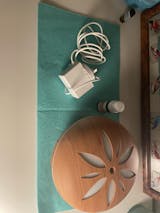Seven Scents
Best-Selling Essential Oil Roller...
$79.95
$119.85
Best-Selling Essential Oil Roller Blends Trio – Handcrafted in small batches in our Lyall Bay shop in Wellington.
Complete Aromatherapy Wellness Set
Experience our three most-loved essential oil rollers in one perfectly curated set. This therapeutic-grade trio gives you powerful support for sleep, stress relief, and immune health - everything you need to feel your best through all of life's moments. Save when you buy the collection and always have the right blend on hand.
Bundle Includes:
• Best Sleep Roller - Lavender, Ylang Ylang, Orange, Sandalwood
• Beat Stress Roller - Lavender, Ylang Ylang, Lime, Patchouli, Clove
• Cold & Flu Roller - Lavender, Lemon, Peppermint, Eucalyptus
Carrier Oil: Organic Coconut Oil in all blends
Total: 3 x 10ml glass roller bottles
Grade: 100% pure, therapeutic grade essential oils
Best For: Complete wellness support, Gift giving, Year-round health
What's Included in Your Trio
Best Sleep Roller - Drift into peaceful slumber with calming lavender, relaxing ylang ylang, soothing orange, and grounding sandalwood. Perfect for bedtime routines and restful sleep support.
Beat Stress Roller - Find instant calm with stress-melting lavender, emotionally-balancing ylang ylang, uplifting lime, grounding patchouli, and warming clove. Your go-to for anxious moments and emotional balance.
Cold & Flu Roller - Beat congestion with soothing lavender, immune-boosting lemon, cooling peppermint, and decongestant eucalyptus. Essential support during cold and flu season for clear breathing and respiratory relief.
Why This Trio is Perfect
Complete coverage: Support for sleep, stress, and immunity in one set
Better value: Save money compared to buying rollers individually
Always prepared: Have the right blend for whatever life throws at you
Customer favourites: Our three best-selling rollers based on reviews
How to Use Your Roller Trio
Morning: Reach for Beat Stress before work or during anxious moments. Apply to wrists, temples, and behind ears.
Daytime: Use Cold & Flu at first sign of congestion. Roll on chest, throat, and upper back.
Evening: Wind down with Best Sleep 15-30 minutes before bed. Apply to wrists, temples, and bottom of feet.
Each roller is pre-diluted and safe for direct skin application. Keep one in your bag, one at work, and one on your bedside table for 24/7 wellness support.
Why Choose Seven Scents Essential Oil Rollers
Our aromatherapy essential oil roller blends combine therapeutic benefits with convenient, on-the-go application:
Ready to use: Pre-diluted and safe for direct skin application
Therapeutic grade: 100% pure essential oils, never synthetic
Organic carrier oil: Nourishing coconut oil hydrates skin
Sustainable packaging: Glass bottles with stainless steel rollers, not plastic
Made in New Zealand: Small batch, handcrafted in Wellington
Vegan and cruelty-free
Travel-friendly 10ml sizes
Thank you for supporting our small business!

























































































